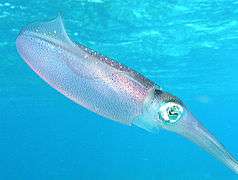Lophotrochozoa
| Lophotrochozoa Temporal range: Early Cambrian - Recent | |
|---|---|
 | |
| Caribbean reef squid or Sepioteuthis sepioidea is a complex lophotrochozoan. | |
| Scientific classification | |
| Kingdom: | Animalia |
| Subkingdom: | Eumetazoa |
| (unranked): | Bilateria |
| (unranked): | Protostomia |
| Superphylum: | Lophotrochozoa Halanych et al., 1995 |
| Phyla | |
The Lophotrochozoa (/ləˌfɒtroʊkoʊˈzoʊə/, "crest/wheel animals") are a major grouping of protostome animals. The taxon was discovered based on molecular data.[1] Molecular evidence such as a result of studies of the evolution of small-subunit ribosomal RNA (rRNA) supports the monophyly of the phyla listed in the infobox shown at right.[2]
Terminology
The word "lophotrochozoan" is sometimes equated with spiralian.[3] When used in a broader sense (sensu lato), it can include rotifers and platyhelminthes.[4] When used sensu stricto, it refers to a subgroup of Spiralia.
Groups
The Lophotrochozoa comprise two groups, the trochozoans and the lophophorata. The exact relationships between the different phyla are not entirely certain.
- Trochozoans produce trochophore larvae, which have two bands of cilia around their middle.[5] Previously these were treated together as the Trochozoa, together with the arthropods, which do not produce trochophore larvae but were considered close relatives of the annelids because they are both segmented. However, they show a number of important differences, and the arthropods are now placed separately among the Ecdysozoa. The Trochozoa include the Nemertea, Mollusca, Sipuncula, and Annelida.[5]
- The Lophophorata are united by the presence of a lophophore, a fan of ciliated tentacles surrounding the mouth, and so were treated together as the lophophorates. They are unusual in showing radial cleavage, and some authors considered them deuterostomes. The ‘clade’ Lophotrochozoa was founded on evidence from 18S ribosomal RNA,[1] but a later study on LSU and SSU ribosomal genes suggested that the Lophophorata is polyphyletic.[6]
Other phyla are included on the basis of molecular data.
| |||||||||||||||||||||||||||||||||||||||||||||||||||||||||||||||||||||||||||||||||||||||||||||||||||
| A phylogenetic tree of the Lophotrochozoa[7][8][9] |
See also
References
- 1 2 Halanych, K.M., Bacheller, J., Liva, S., Aguinaldo, A. A., Hillis, D.M. and Lake, J.A. (17 March 1995). "18S rDNA evidence that the Lophophorates are Protostome Animals". Science. 267: 1641–1643. doi:10.1126/science.7886451. PMID 7886451.
- ↑ Hervé, Philippe; Lartillot, Nicolas; Brinkmann, Henner (May 2005). "Multigene Analyses of Bilaterian Animals Corroborate the Monophyly of Ecdysozoa, Lophotrochozoa, and Protostomia". Molecular Biology and Evolution. 22 (5): 1246–1253. doi:10.1093/molbev/msi111.
- ↑ Giribet G (April 2008). "Assembling the lophotrochozoan (=spiralian) tree of life". Philos. Trans. R. Soc. Lond., B, Biol. Sci. 363 (1496): 1513–22. doi:10.1098/rstb.2007.2241. PMC 2614230
 . PMID 18192183.
. PMID 18192183. - ↑ "Explanations.html". Retrieved 2009-06-28.
- 1 2 "Introduction to the Lophotrochozoa". University of California, Berkely. Retrieved 2016-09-05.
- ↑ Passamaneck, Y.; Halanych, K.M. (July 2006). "Lophotrochozoan phylogeny assessed with LSU and SSU data: evidence of lophophorate polyphyly". Mol Phylogenet Evol. 40 (1): 20–28. doi:10.1016/j.ympev.2006.02.001. PMID 16556507.
- ↑ Jordi Paps, Jaume Baguña & Mart Riutort (July 2009). "Bilaterian Phylogeny: A Broad Sampling of 13 Nuclear Genes Provides a New Lophotrochozoa Phylogeny and Supports a Paraphyletic Basal Acoelomorpha". Molecular Biology and Evolution. 26 (10): 2397–2406. doi:10.1093/molbev/msp150. PMID 19602542.
- ↑ Struck, T.H.; Schult, N.; Kusen, T.; Hickman, E.; Bleidorn, C.; McHugh, D.; Halanych, K.M. (5 April 2007). "Annelid phylogeny and the status of Sipuncula and Echiura". BMC Evolutionary Biology. 7: 57. doi:10.1186/1471-2148-7-57. PMC 1855331
 . PMID 17411434.
. PMID 17411434. - ↑ Hausdorf, B.; Helmkampf, M.; Meyer, A.; et al. (December 2007). "Spiralian Phylogenomics Supports the Resurrection of Bryozoa Comprising Ectoprocta and Entoprocta". Molecular Biology and Evolution. 24 (12): 2723–2729. doi:10.1093/molbev/msm214. PMID 17921486.
Further reading
| Wikispecies has information related to: Lophotrochozoa |
- Podsiadlowski R. 2009. Phylogeny and mitochondrial gene order variation in Lophotrochozoa in the light of new mitogenomic data from Nemertea. BMC Genomics 2009, 10:364. doi:10.1186/1471-2164-10-364